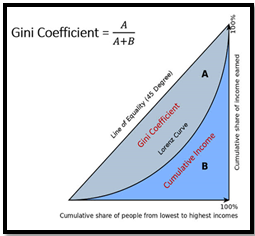INCOME INEQUALITY DECLINES: SBI RESEARCH
Why in the News?
- State Bank of India’s Economic Research Department disputes claims of a K-shaped recovery as “prejudiced” and “ill-concocted.”
Key Highlight of the Research:
- India’s income inequality decreases, fueled by a higher tax base.
- Shifting taxpayers to higher income brackets contributes to this decline.
- Small firms transforming into larger entities and evolving consumption trends, like increased food ordering, signify reduced inequality.
- A substantial 363% rise in taxpayers moving to higher income brackets results in an added income of 21.3%.
- Income growth is evident across all classes with reduced skewedness, indicating a shift toward middle-income levels.
- The Gini coefficient exhibits a noteworthy decrease in income inequality from 0.472 to 0.402 during FY14-FY22.
| Key Terms
Gini coefficient · The Gini coefficient is a statistical measure of income inequality within a population. · It ranges from 0 to 1, where 0 represents perfect equality (everyone has the same income) and 1 signifies perfect inequality (one individual has all the income).
· The coefficient is calculated by plotting the Lorenz curve, a graphical representation of income distribution, and measuring the area between this curve and the line of perfect equality. · A smaller Gini coefficient indicates a more equal distribution. K-shaped recovery K-shaped recovery refers to an economic rebound where different sectors or groups recover unevenly. While some segments experience growth or improvement, others face decline or stagnation. |

 Source: Steemit
Source: Steemit

